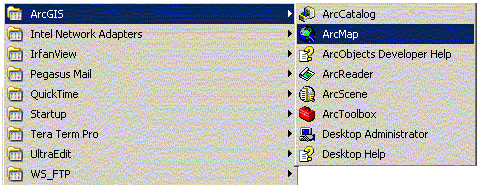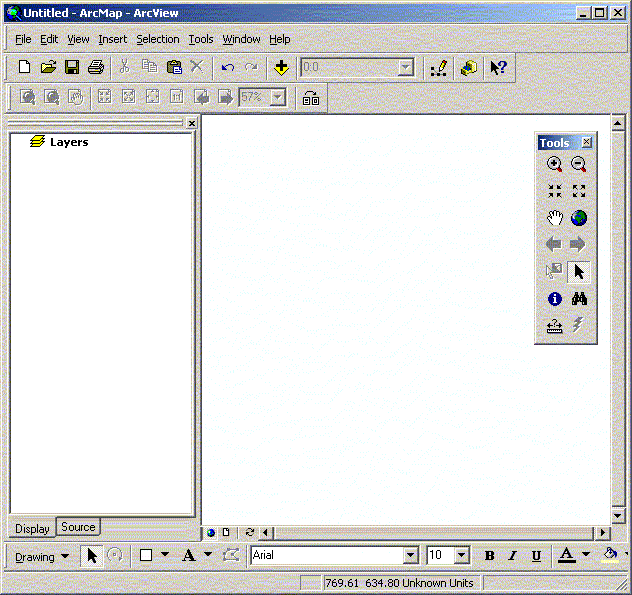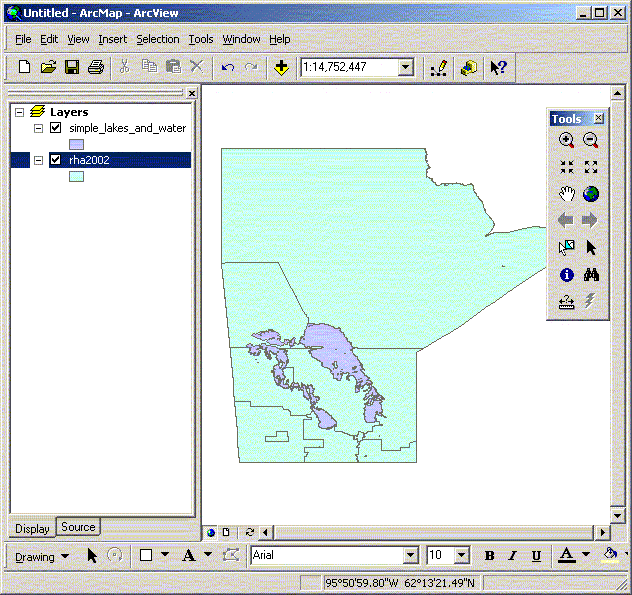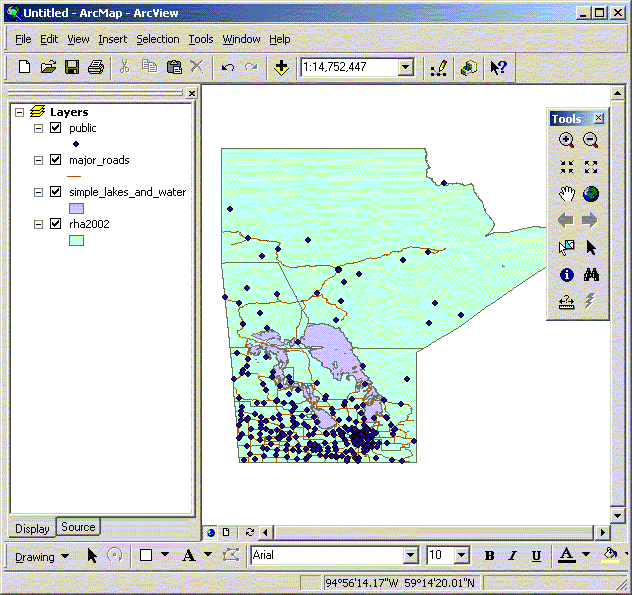| CREATING
A MAP
The following section deals primarily with displaying maps using
ArcMap. The ArcMap application consists of a map display window
for viewing spatial data, a table of contents listing layers shown
in the display, and a variety of tools for working with spatial
data. Similar to most current windows applications ArcMap can be
modified to meet your specific needs with regard to available tools,
tool bars, and other preferences.
Starting ArcMap
From the Start menu, go to Programs, ArcGIS, ArcMap.

Data View & Frames
In ArcMap, you begin with a map document. This is a collection
of all tables, data frames, layers, and charts. When working with
a map document it is important to remember that it does not contain
any of the spatial or tabular data. The document is a collection
of pointers to data files and instructions on how to combine or
display those files as a unit. The first component of a document
we will be dealing with is called a Frame. A frame is, essentially,
your map or one view of the world; ArcMap can have multiple frames
all placed in one layout or view. It is where you look at and manage
much of your mapped data. When you open a new document in ArcMap,
your view will simply be a blank page.

From here, you add layers. Layers are the visual components of
your map and work in layers. There are four basic kinds of layers;
polygons, lines (arcs), points, grids (raster). Map files used by
ArcView include ArcView Shape files (.shp), ArcInfo coverage files
(E00), CAD files such as AutoCAD (.dxf), and raster or bitmap images.
If you want to add a map of Manitoba to your view, you would click
on the “add data” button on the toolbar or select from
the File menu.


Open the shape file D:\gis_course\rha\rha2002.shp. This shows you
a polygon layer containing the outlines of the Manitoba RHA boundaries.
The outer boundary of this theme is roughly in the shape of Manitoba.
Click on “add data” again, and open D:\gis_course\simple_lakes_and_water.shp.
Multiple shape files can be selected when adding views by holding
down the shift/control key when selecting files. A single shape
file can be added to a view multiple times to show different attributes
of the same features. The left frame of your view is called the
table of contents and it is used to keep track of your themes. Each
layer is displayed, by default, with a legend below the layer name.
Check (click on) the boxes to display the layer in your view. You
should now have a view that looks something like the image below.

As you add layers, they show up in the view in layers and are listed
in the Table of Contents. The first layers form the bottom layers,
while the most recent layers form the top layers. It is important
that the layers with the largest polygons are added first, so that
they form the bottom layers. This actually applies to all types
of layers. To understand why, try adding simple_lakes_and_water.shp
before rha2002.shp, activate them both, and see what your view looks
like. You can fix this by “dragging” your rha.shp layer
to below the lakes and waters layer in the table of contents.
Once you have added your polygons, the next layers to add are arcs.
(This is in keeping with the wisdom of adding the largest featured
layers first and the smallest layers last.) Arcs are lines, commonly
road systems on our maps. To add roads to your Manitoba map, click
on “add data” and open D:\gis_course\rha\major_roads.shp.
The smallest layers (and thus the last to be added to our view)
are called points. These are usually locations of hospitals, schools,
community centres, or other discrete locations. We will add public
schools to our map, by clicking on “add data” and opening
D:\gis_course\rha\public.shp. Your map now has four layers: first
the rha boundaries (a polygon), next the lakes (a polygon), next
the major roads (lines), and finally, the locations of public schools
(points). If you have all of your layers turned on at once, you
should have a view that looks something like the figure below.

 Home
Home
 Introduction
Introduction |
NEXT
 Basic Use: Data Frame Tools
Basic Use: Data Frame Tools |
|
